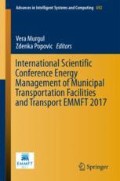Abstract
Currently, there’s a problem with the big population on the earth’s surface. This has an extremely negative impact on the transport network of cities and the overall comfort of living. There is a problem to reach in the morning for work, and in the evening home, roads are overloaded with transport in rush hours. In some cities, traffic jams are a constant problem. The construction of intercepting parking facilities near the metro, multi-level roads and other elements of transport infrastructure only lead to temporary improvement. The best solution for this problem is urbanization of the underground space. The purpose of the research was to examine the efficiency of reconstruction of underground structures for new facilities. The study showed that reconstruction of existing underground structures for new appliance is more quick and cheap. In our days there’re some objects, which have been restored and now they are amusement parks, shopping centers, etc. Were described the plans for future renovations, which will reduce the density of urban development on the surface of the earth and to repurpose unused underground structures. It was also noted that due to lack of existing underground structures new constructions are often used. There were given some recommendations of the organization and development of the underground space.
Access this chapter
Tax calculation will be finalised at checkout
Purchases are for personal use only
References
Alekseev, Yu., Belyaev, V.: Underground buildings and structures as a system element of interacting spatial environments of urban development. Vestnik 2, 6–10 (2012)
Pustovojtenko, V., Gavrish, O.: Organization of integrated development of the underground space of megacities, vol. 32, pp. 106–110 (2010)
Denisov, Yu., Koren’kova, G.: On the need to develop. The underground space of cities, vol. 11, pp. 99–103 (2016)
Vartanov, A., Petrov, I., Fedash, A.: The main tendencies of underground construction and development of the subsoil of cities and the problems of designing underground objects in megacities and zones of urban industrial agglomerations, vol. 10, pp. 160–164 (2015)
Qihu, Q.: Present state, problems and development trends of urban underground space in China, vol. 55, pp. 280–289 (2016)
Hachatryan, V.: Design and development of underground space under buildings in the environment of existing buildings, vol. 6–1, pp. 112–115 (2015)
Labbe, M.: Architecture of underground spaces: from isolated innovations to connected urbanism. Tunn. Undergr. Space Technol. 55, 153–175 (2016)
Pleshanova, M., Ivanova, A.: Underground construction is below zero, vol. 1, pp. 160–162 (2016)
Korotaev, D.: The use of underground space in Moscow, vol. 1, pp. 39–44 (2009)
Vahaaho, I.: An introduction to the development for urban underground space in Helsinki, vol. 55, pp. 324–328 (2016)
Pozel’skij, E.: Economic effect and reliability of long-term underground structures in the construction of high-rise buildings, vol. 6, pp. 10–11 (2011)
Zhou, Y.: Assessment and planning of underground space use in Singapore, vol. 55, pp. 249–256 (2016)
Sevryukova, K.: Osnovnye ehtapy razvitiya podzemnoj urbanistiki (2017). http://izron.ru/articles/problemy-i-dostizheniya-v-nauke-i-tekhnike-sbornik-nauchnykh-trudov-po-itogam-mezhdunarodnoy-nauchno/sektsiya-10-stroitelstvo-i-arkhitektura-spetsialnost-05-23-00/osnovnye-etapy-razvitiya-podzemnoy-urbanistiki
Lezina, E.: The current state and prospects for the development of underground urban planning, vol. 5, pp. 71–73 (2015)
http://www.bbc.com/russian/society2015/05/150513_vert_fut_will_we_ever_live_undeground (2017)
Semenova, O.: Teoreticheskie problemy gradostroitel’nogo planirovaniya podzemnoj chasti gorodov (2017). http://www.undergroundexpert.info/stati-i-doklady/item/1788-problemy-planirovaniya
ITA-AITES. Urban underground (2017). https://www.ita-aites.org/ru/use-of-underground-spaces/underground-planning
Skupov, B.: Vse glubzhe, glubzhe i glubzhe. Strategiya innovacionnogo razvitiya podzemnogo gorodskogo prostranstva (2017). http://ardexpert.ru/article/4137
Sysoev, A.: Underground city (2017). http://pm-world.ucoz.ru/blog/podzemnye_goroda/2012-01-24-20
Brajla, N., Lazarev, Y., Romanovich, M., Simankina, T., Ulybin, A.: Modern problems of building science. Technol. Technol. 141 (2017)
Simankina, T., Braila, N., Kanyukova, S.: Reclamation trend of underground construction, vol. 165, pp. 1757–1765 (2016)
Admiraal, H., Cornaro, A.: Why underground space should be included in urban planning policy. And how this will enhance an urban underground future, vol. 55, pp. 214–220 (2016)
Besner, J.: Underground space needs an interdisciplinary approach, vol. 55, pp. 224–228 (2016)
http://russian7.ru/post/commercial/2016/02/21/urbanizaciya-podzemnogo-prostranstva (2017)
https://www.ita-aites.org/ru/how-to-go-undergound/operation/maintenance (2017)
Adigamova, Z., Lihnenko, E.: The development of underground space as a solution to urban urbanization problems, pp. 4–8 (2016)
Anoshkin, V.: Modern aspects of underground urban planning, vol. 30, pp. 6–11 (2015)
Bazilevich, M., Kozyrenko, N., Ivanova, A.: Typology of underground structures, vol. 1, pp. 133–136 (2011)
Belyaev, V.: Comprehensive approach to the development of the underground space of cities as a way to their sustainable development, vol. 9, pp. 109–114 (2014)
Belyaev, V.: Urgent tasks of development of the underground space of the capital, vol. 1, pp. 77–79 (2011)
Author information
Authors and Affiliations
Corresponding author
Editor information
Editors and Affiliations
Rights and permissions
Copyright information
© 2018 Springer International Publishing AG
About this paper
Cite this paper
Utkina, E., Pshennikov, K., Braila, N. (2018). The Development of Underground Construction as a Way to Improve the Organization of Traffic. In: Murgul, V., Popovic, Z. (eds) International Scientific Conference Energy Management of Municipal Transportation Facilities and Transport EMMFT 2017. EMMFT 2017. Advances in Intelligent Systems and Computing, vol 692. Springer, Cham. https://doi.org/10.1007/978-3-319-70987-1_38
Download citation
DOI: https://doi.org/10.1007/978-3-319-70987-1_38
Published:
Publisher Name: Springer, Cham
Print ISBN: 978-3-319-70986-4
Online ISBN: 978-3-319-70987-1
eBook Packages: EngineeringEngineering (R0)

